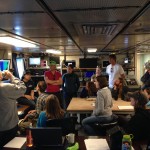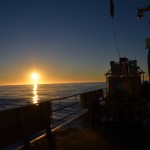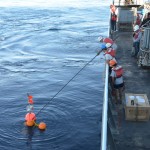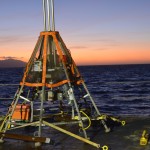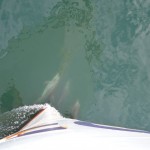So, Al and Evelyn and Wendi made all this effort to solicit some retrospective, what-I-learned-from-Chief-Science-Training posts and make sure they were the last things posted on the blog, and then I came in like LOOK AT THE COOL PICTURES and ruined it. So here I am with one last post, which I will begin by inviting you to read the other thoughtful retrospective posts below this one.
Participating in this cruise has been a learning experience in so many ways, going back to before we even got on the ship. I was selected as a co-chief scientist back when we were all notified that we’d been accepted for this cruise, I think based solely on the criteria that I’d been to sea to take cores before (thanks, Yair). The other three co-chiefs and I were given a few weeks to put together a cruise plan for 21 different people with 21 different projects, with the only criteria being “you can go wherever you want within 200 nm of San Diego, except Mexico.” We worked well together via Skype and e-mail planning things out, and the cruise plan went through many iterations until we settled on something that we all felt really good about.
Like all good plans, it barely survived the first station (at which the MC failed to trigger and required a second deployment), and our on-the-fly revisions didn’t stop until we finished coring at the last station on Friday night. My favorite catalyst of change was the notification from the second mate that one of our initial coring sites was in the middle of an old Navy ordnance disposal dumping ground, which is not a good place to being lowering gear to the seafloor.
The nature of this cruise, with no unifying science goal and no real head chief scientist, is fairly unique, but the group problem-solving every time something had to change was fun and rewarding, and I think we all really enjoyed that aspect of the chief scientist experience. This is drifting a bit from the subject of What I Learned About Being a Chief Scientist, but I think we were very lucky in that everyone got along very well, worked well together, and were good about prioritizing each other’s research goals along with their own. This kind of large cruise could easily develop a too-many-cooks in the kitchen dynamic, but we all worked very well together, and it definitely contributed to the success of everyone’s science goals.
But back to Chief Scientist things: I think this extensive planning along with the ability to easily roll into back-up plans is the main lesson they were trying to teach us, and it seems to me that it’s probably the most important aspect of being a Chief Scientist. Our cruise plan changed daily, sometimes in fairly significant ways, but we were always ready to change things around to accomplish the same goals. This type of flexibility is something that I am familiar with (“Scramble; Be Flexible” was a mantra at summer job I had as a backcountry guide through college), even at sea (thanks Yair; I learned to never waste a minute of ship time if you can help it), but it’s a lot of fun to think on your feet and adapt like that. I think the main thing I took away from this cruise is that I really like doing this, and can’t wait to sail again as a real chief scientist on my own research cruise.
I also spent the whole week with that really awesome feeling of “I can’t believe I get paid to do this” that I’ve been chasing since that first summer job that I really liked. I really can’t believe I get paid to do things like this, and feel so lucky to get these opportunities.
Posted by Chris
- pre-cruise cookout
- Computer Lab
- Bow Dolphins
- Northern Right Whale Dolphin
- Glider Deployment
- Chief Scientist Hat
- I’m honestly shocked there weren’t more food pictures on this blog
- CTD deployment
- Sunset
- sed trap recovery
- Watching an A-Frame deployment
- sunset
- Strobe on the multicorer camera
- cores
- extruding
- working late
- water sampling (and supervising)
- taking a break during transit
- The Coring team
- The seafloor
- tiny starfish
- Aircraft Carrier blocking the channel
- harbor seal chilling
- Dolphin looking back
- Photo credit: Robyn Von Swank, instagram @vonswank


